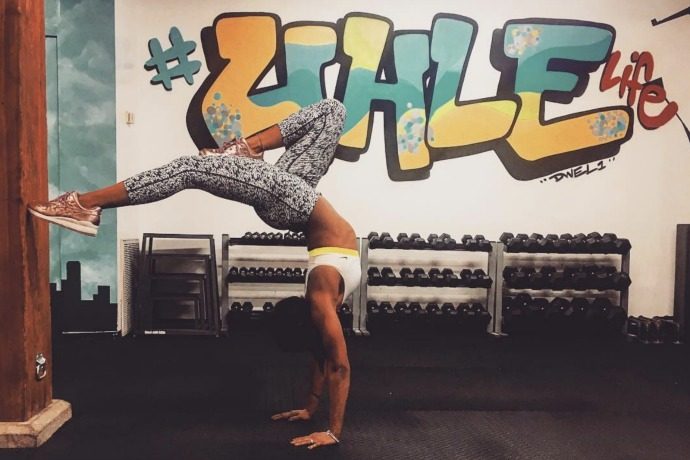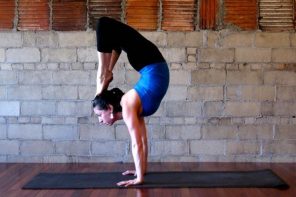As rapper Future mumbled over the speakers, I exhaled and crouched down for a very shaky approximation of a warrior pose. This was my first trap yoga class, and I was determined not to look like the novice I was.
Studio 262 is a recent addition to South Los Angeles. Blocks away from the University of Southern California, the new space is becoming a hub for students as well as locals. Among their many class offerings, the one that caught my eye was trap yoga.
Trap yoga involves doing vinyasa flows to the beat of trap music, a bass-filled, gritty sub-genre of hip hop that originated in the South. It’s become somewhat of a gateway for people of color who wouldn’t feel at ease in typical yoga spaces, which are usually predominantly white and upper-class. Vaguely familiar with the practice from social media—where a search of the #trapyoga tag on Instagram shows a variety of skin tones, genders and body types—I was eager to experience it firsthand.
When I met Brandi Polk, the owner, at the end of the studio’s final class for the day, I notice she’s wearing a string of beads around her neck. She explains that they’re mala beads, used for meditation and reflection in the Hindu tradition. One meditates over each of the 108 beads, and when they’ve completed the beads, they’re allowed to wear it around their necks. When I said it reminded me of rosary beads within the Catholic tradition, Polk responds, “It’s all the same really.”
In January, the Los Angeles native opened her studio on Figueroa Street, just two minutes from where she grew up on 29th and Vermont. Polk, who has been practicing yoga for five years and benefited greatly, wanted to find a way to make yoga relatable and accessible for people within her community. That’s where trap yoga came in. She hosted a trap yoga workshop as a one-off and after it was a hit, she added it to the yoga and pilates schedule. It quickly became the biggest draw for the studio.
“Most studios are upper-class white spaces where women are on vacation from their kids. Being conscious of your mind and body isn’t something that should be exclusive to white people.”—Asia Nichole Jones
“I love yoga. I love trap music. Why do they have to be mutually exclusive interests,” says Polk, who’s partial to Gucci Mane, one of the earlier trap artists.
“You hear yoga and you think one thing, but when you hear trap yoga, you think something different. It gets people who wouldn’t be interested in yoga, interested in yoga and introduces it to a new demographic.”
In her mission to make her studio accessible to South Los Angeles residents, she makes her classes only ten dollars each, and five dollars for Friday classes. This gives would-be yogis more affordable options in a city where yoga—a practice that requires little-to-no equipment—somehow averages about twenty bucks a class, a barrier to many. Polk hopes to combat the pop culture image of yoga as a pastime of the privileged, and trap yoga is a vehicle for that. When the studio first opened, it was mostly USC students, but now she sees more people from the neighborhood and more people of color, particularly women of color.
“Given what’s happening in the world right now, people of color need more ways to direct our energy, not just externally but internally as well. Women of color especially deal with a lot every day, and yoga gives you another set of tools for navigating the world.”
I became more curious about the origins of trap yoga and decided to find its creator, a search that led me to Asia Nichole Jones, a Chicago native who developed the practice in 2014 while on retreat at a wildlife preserve in San Diego County. Despite conflicting claims on ownership of the term “trap yoga,” the only existing trademark is registered by Jones, according to the United States Patent and Trademark Office.
She began practicing vinyasa yoga while still a college student in 2010, and became a certified instructor in 2014. Feeling out of place as the only black girl in the yoga studios she visited, Jones would often sit on her deck at home and play artists like Migos or Kendrick Lamar as she did her asanas. It became a sacred, personal time where she was able to replenish her spirit. She wanted to share this feeling with as many women of color and as many people as possible, so she began offering trap yoga classes after gaining her certification.
“Most studios are upper-class white spaces where women are on vacation from their kids. Being conscious of your mind and body isn’t something that should be exclusive to white people,” says Jones.
“Though everyone is welcome, I made this space and this practice for women like myself. I’ve always wanted to bring women of color to the mat. I’ve had people who didn’t practice before but are now dedicated yogis, and that’s always rewarding.”
In addition to trap yoga, Jones also created TwerkAsana, a form of dance yoga that combines traditional poses with rhythmic gyrating. “We’re still holding the integrity of the practice, but we’re moving, we’re twerking, and we’re having fun.”
“I went to the mountaintop, I learned yoga under a guru, and here I am falling asleep in yoga classes. I was bored out of my mind.” —Britteny Rogers
Jones appreciates how yoga respects all belief systems, and it greatly impacted her spirituality. One of the yoga teachers she trained under was heavily Buddhist, while the other teacher was Christian. The duality of their training proved meaningful to Jones.
“I was able to take everything I was learning and morph it into my own understanding. Trap yoga allows you to make new ideas of your own without offending your current religion. I was once a super devout Christian, and I have a lot more ideas about my creator now from practicing yoga. It’s turned into another type of worship of me.”
Trap yogi Britteny Rogers, who hails from Northern California, was actually a Pentecostal minister before she found yoga. When she became interested in the practice, she decided to eschew U.S. studios and traveled to India to study the yoga there. The choice forced her to reconcile her Pentecostalism with her new passion.
“My yoga made it difficult to maintain my religious relationships, so much of that ended when I announced I was going to India. They couldn’t believe I was trading in my white Jesus card for yoga,” says Rogers. “I started a new spiritual journey of understanding what it means to be a woman of color and the divinity in that. I just don’t believe in rule books anymore.”
When she returned to the U.S., she found yoga classes here to be lacking spiritual resonance.
“I went to the mountaintop, I learned yoga under a guru, and here I am falling asleep in yoga classes. I was bored out of my mind.”
Whenever Rogers practiced at home, she usually listened to trap music. One day, she decided to take her bluetooth headset to the studio and listen to it during class.
“I could tell it annoyed the teachers, but when I was there listening to Future while in this quiet, white studio, I was like ‘wow, this is something.'”
A friend who had a studio asked if she would want to teach a trap yoga class. Rogers agreed, and the 60-person class she signed up to teach sold out in just a few hours. And it kept selling out over and over. At the first class, she was overwhelmed.
“I had never seen so many plus-sized people, so many queer folks, so many men in baggy pants and fitted caps. That chemical smell when you open a brand new yoga mat for the first time? That was everywhere. I was brought to tears.”
“Especially for women of color, we’ve been conditioned to take care of the world, so when you take care of yourself, you feel selfish. It gives women of color permission to love themselves and permission to say no to things.”
At the time, Rogers was pursuing a master’s degree in advanced practice nursing. Soon after that first class, she quit the program “in a dramatic fashion,” and never looked back. She has been touring the world teaching trap yoga ever since, with her work taking her everywhere from Shanghai to Rio de Janeiro. She’s now professionally known as Yoga Bae.
To complement her trap yoga classes, she created “ratchet affirmations,” self-assertions that use language typically associated with the hood to encourage one to say no to the negative elements in ones life and yes to joy.
“The words we use are vulgar and disrespectful like the music we listen to, but the overall message is positivity.”
As much as Western culture has taken yoga and colonized it for capitalist ends, Rogers still thinks about what it means when the black community repurposes yoga. She feels trap yoga isn’t a response to its originators, but more a response to what the United States did to yoga, which was make it expensive and bland.
https://www.instagram.com/p/BVcvL8kg0nM/?taken-by=trapyogabae
“I would be lying if I said we’re honoring the Bhagavad Gita because we’re not. Appropriation is real, and I question my own motives as well because I know that’s not what I learned in India. And I wonder what my guru thinks when he finds me online since that’s not what he taught me. We used to fight about these things.”
Dr. Andrea R. Jain, an expert on the history of yoga and author of Selling Yoga: From Counterculture to Pop Culture, feels that reinvention and replication has always been part of the history of yoga, and doesn’t believe all appropriation is automatically colonialist or imperialist.
“It’s not like there’s some authentic, original tradition. Yoga has always been pluralistic and divergent. Appropriation is bad when it’s done in service to profit or the concentration of wealth. When you have appropriation trying to subvert various forms of oppression, then it’s a good thing.”
Rogers feels what makes trap yoga so relevant, especially now, is that it gives people a moment to take care of themselves in a space that feels native and comfortable.
“Especially for women of color, we’ve been conditioned to take care of the world, so when you take care of yourself, you feel selfish. It gives women of color permission to love themselves and permission to say no to things. For those who’ve stepped outside of organized religion and don’t feel seen, they are seen in trap yoga.”
Rogers finds there’s a lot of crossover between how she interacted with people as a minister, and how she interacts with her yoga students now. Even though she is no longer Pentecostal, people have approached her after attending a class and asked if she was raised in the church, because of her cadence and energy.
“I probably still sound like a minister when I teach and will have words come together that sound similar to Bible verses. But I throw in a ‘bitch’ at the end, so it’s a little different.”








